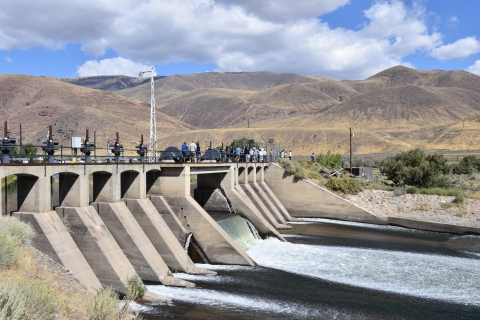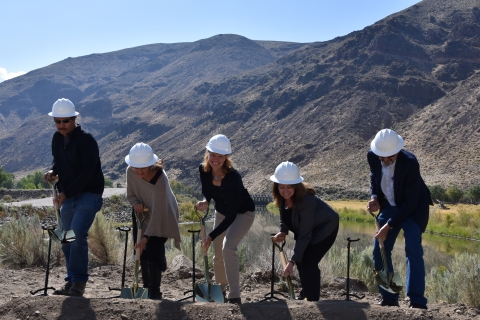In 1905, the same year Albert Einstein introduced E=mc2 to the world, a newly formed U.S. Reclamation Service (now Bureau of Reclamation) unveiled its first large-scale water infrastructure project in Nevada. Commissioned by President Theodore Roosevelt, the Derby Dam was constructed to divert water for irrigation from the Truckee River and Pyramid Lake.
After the construction of Derby Dam, water flowed towards Fallon, Nevada, the desert turned shades of green and communities expanded, but the shift in water management also took its toll on one of Nevada’s most prized native sportfish, the Lahontan cutthroat trout. Photo courtesy of Greg Ritland.
With the dam in place, water flowed towards Fallon, Nevada. The desert turned shades of green and communities expanded, but the shift in water management also took its toll on one of Nevada’s most prized native sportfish, the Lahontan cutthroat trout.
The trout once roamed the waterways of Nevada, growing as large as 60 pounds and serving as an important predatory fish in northern Nevada. But with changes in water use, populations of the mammoth fish began declining. Operation of the dam reduced water levels in the Truckee River, straining habitat conditions, while the structure itself cut the trout off from spawning grounds on the other side of the dam. By the mid-1960s, the fish had been completely eliminated from Pyramid Lake.
Almost 50 years after the Lahontan cutthroat trout was listed under the Endangered Species Act, agencies are investing in a game-changing, fish-friendly infrastructure project at Derby Dam to help bring back the legendary fish. Announced on Sept. 11, 2019, construction of a fish passage fish passage
Fish passage is the ability of fish or other aquatic species to move freely throughout their life to find food, reproduce, and complete their natural migration cycles. Millions of barriers to fish passage across the country are fragmenting habitat and leading to species declines. The U.S. Fish and Wildlife Service's National Fish Passage Program is working to reconnect watersheds to benefit both wildlife and people.
Learn more about fish passage structure will allow Lahontan cutthroat trout to complete their natural migration, swimming back and forth between Pyramid Lake and historic spawning grounds.
Since the trout received federal listing status in 1970, the U.S. Fish and Wildlife Service has worked with the Pyramid Lake Paiute Tribe, Reclamation and the Nevada Department of Wildlife to reestablish a self-sustaining population of the fish in Pyramid Lake while also providing reliable water sources to residents of the Silver State. This investment in infrastructure along the existing Derby Dam structure will help to accomplish both of these goals.
“The addition of a fish screen to our existing water infrastructure will allow this iconic species to travel beyond Derby Dam and complete their natural migration route for the first time in more than a century,” said Jody Holzworth, deputy regional director for U.S. Fish and Wildlife Service.
The fish screen is designed to work with the diverted flow of water rather than against it, providing fish protection by allowing fish and debris to move above and over the surface of the screen material. The horizontal fish screen coming to Derby Dam is the largest ever commissioned, and the first for Reclamation.
Fish passage at Derby Dam has been a priority conservation project for Lahontan cutthroat trout recovery for more than two decades. In 2001, the Service and Reclamation designed and completed a fish bypass around Derby Dam. It hasn’t yet been used, though, because of the lack of a fish screen to prevent fish from being diverted to the Carson River.
Since then, the two agencies have been working to implement the protection portion of the Derby Dam passage improvements. Reclamation selected the horizontal fish screen technology and entered into a cooperative agreement with Farmers Conservation Alliance for its design, construction and commissioning. Construction will be completed in fall 2020.
At the groundbreaking event, Reclamation Commissioner Brenda Burman praised the construction of the fish screen saying, “It’s a milestone in the history of Reclamation. The fish screen is a critical investment in modernizing our infrastructure to provide reliable water supplies in an environmentally sound manner. We’re helping reconnect the fish with the river.”
Numbers of Lahontan cutthroat trout migrating in the Truckee River from Pyramid Lake are increasing every year. With a fish screen in place, the Service anticipates that more fish will reach natural spawning grounds, improving population numbers in the area and the chance to see wild-spawned fish swimming through the Reno/Sparks area.
“This marks the culmination of a long-standing partnership between the Service, Reclamation and the Pyramid Lake Paiute Tribe, to conserve Nevada’s precious terminal lake ecosystem and recover this well-loved sportfish,” said Holzworth. “We are thrilled to see this project come to life.”
More than a century after the construction of Derby Dam, Lahontan cutthroat trout will again have access to spawning grounds. The investment in securing fish passage will also improve access to recreation and angling along the Truckee River, an internationally recognized fishery, and will mark a significant step towards restoring watershed connectivity for aquatic animals including Lahontan cutthroat trout.






